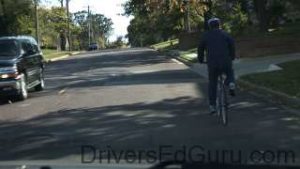Stage 4: You Don’t Own the Road (so share it!)
Location: City and Residential Roads, Highways
Length of Lesson: 45 minutes
This lesson involves you, as the all-knowing parent, providing defensive driving commentary as your teen drives around town. The focus of your comments should be about safely sharing the road with trucks, motorcycles, and bicycles.

Trucks
Trucks are intimidating to new drivers for good reason: they’re big and they travel fast. However, it’s important to point out to your teen that these drivers are professionals and are typically the safest drivers on the road due to their vast experience. However, if they do get into an accident, they’re going to cause considerable damage to whatever they hit due to their large size.
- Speed: Truck drivers are in a hurry to get their goods to their destination. This can be dangerous if the driver exceeds the speed limit.
- Drowsy Driving: Truckers spend extended periods of time on the road. While Federal laws regulate how long a truck driver can be on the road between periods of rest, drivers are vulnerable to highway hypnosis.
- Mass: Trucks weigh approximately 20 times your average car. This means it’s going to take them longer to stop and accelerate. It also means that it’s going to destroy pretty much anything that it hits due to its massive momentum.
Tips for sharing the road with Trucks
- Avoid the ‘No Zones’: Trucks have much larger blind spots than cars. There also isn’t a BGE mirror setting for trucks. You’ve probably seen a sign on some trucks that reads, “If you can’t see my mirrors, I can’t see you.” Keep that in mind when traveling near to a truck. The area directly behind a truck as well as most of its right side is completely invisible to the driver. This means that you should them a considerable following distance and you should also avoid traveling in the lane directly to a truck’s right. If you must pass on the right, do so quickly.
- Watch for wide right turns. If you’ve ever watched closely, you’d notice that a truck making a right turn must swing out to the left and far into the intersection to keep its trailer and rear wheels from wiping out everything on the corner. Whenever a truck is making a right turn, give it a lot of room.
- Understand that trucks can’t stop quickly. Like a train, once a truck (finally) gets going, it’s difficult to stop it.
- So, if you’re driving in front of a truck, don’t stop suddenly. The truck can’t stop as quickly as you and if it rear-ends you, your car will be completely destroyed and you may be severely injured or killed.
- If traveling downhill, stay out of a truck’s way. They don’t want to burn out their brakes trying to slow their great momentum.
- If traveling uphill, you should pass a truck. A steep hill will severely limit a truck’s maximum speed.
- Beware the air effects. A truck creates a lot of wind turbulence outside its immediate area. In fact, it’s so severe that it can rock your car as the truck passes you. In addition, a large vacuum is created directly behind and to the sides of a truck. The vacuum pulls things (such as cars) closer to it. So, give trucks breathing room.
- Back off in bad weather. Trucks have 18 wheels which can throw up a lot of water on a rainy day. The deluge is so powerful that it can take your wipers several seconds to clear it. This means that you’re traveling blind until your wipers catch up. So, give trucks ample room when it’s pouring.
Motorcycles

Motorcycles are far more dangerous to their riders than they are to your car. Despite their inherent safety risks, motorcycle sales continue to rise, so you have to learn to share the road with them. Motorcycles prevent several problems:
- They are fast. A motorcycle can appear “out of nowhere” because they can accelerate faster than most sport cars.
- They are small. A motorcycle is small enough to fit inside the small blind spots in the BGE mirror setting. They are also thin enough to drive on a lane line. So, in packed traffic, they are often seen “cutting ahead” of the line by driving in between cars. This can be especially dangerous if, oh, I don’t know, a car decides to switch lanes.
- Many (but not all) motorcyclists drive crazily. I’ve seen motorcyclists whip in and out of traffic at speeds topping 100mph. I’ve also seen motorcyclists standing on their seat and performing all sorts of crazy maneuvers that are a sure-fire way to get yourself killed.
Your job as the parent is to help your teen spot motorcycles. If you can see them, you can give them some room. In most crashes involving motorcycles and cars, the driver of the car stated that they never saw the motorcycle. Whenever you see a motorcycle, point it out to your teen. Also, mention that motorcycles can be obscured by other cars.

Bicycles
Bicycles have the same rights and privileges as cars. As long as there is no posted minimum speed limit, a bicycle can legally ride down the center of a lane whose traffic is traveling at 45mph. While this probably isn’t the safest place for a bike, they have the right to be there.
The rule of thumb with bicycles is to treat them the same as motorcycles and give them a wide berth.
Continue on to Driving in Hazardous Conditions

